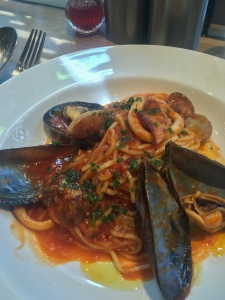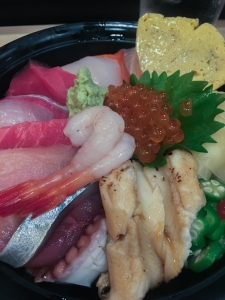In developing this blog, my goal is to help you better plan your own trips, whether that means learning about interesting things I did and incorporating them into your plans or avoiding some of the missteps of my travels. With this mind, I don’t think that a summary of my daily schedule would be particularly useful or interesting. Instead, I will focus this and similar posts on sharing the highlights and lowlights of my experiences, which I hope you find informative and – at least slightly – entertaining.
Hitting the Mark
 Grand Sumo Tournament: Attending the Grand Sumo Tournament was easily my favorite experience in Tokyo and an overall highlight of the trip. While the individual matches last mere seconds, the preparations the wrestlers undertake before each bout are mesmerizing. Lifting and lowering each leg, squatting and standing, standing and squatting. At first, the wrestlers’ actions appear to be aimed at intimidating their competitors, but as the matches continue and the pre-bout warmups remain unchanged, it starts to look more like routine. That is, until the upper-division wrestlers begin competing.
Grand Sumo Tournament: Attending the Grand Sumo Tournament was easily my favorite experience in Tokyo and an overall highlight of the trip. While the individual matches last mere seconds, the preparations the wrestlers undertake before each bout are mesmerizing. Lifting and lowering each leg, squatting and standing, standing and squatting. At first, the wrestlers’ actions appear to be aimed at intimidating their competitors, but as the matches continue and the pre-bout warmups remain unchanged, it starts to look more like routine. That is, until the upper-division wrestlers begin competing.  While they engage in many of the same theatrics, they bring added flair – dramatically tossing hand chalk in the air. Of course, the bouts themselves improve in quality and excitement, as well, when the main matches get underway.
While they engage in many of the same theatrics, they bring added flair – dramatically tossing hand chalk in the air. Of course, the bouts themselves improve in quality and excitement, as well, when the main matches get underway.
 Tournaments are held six times a year, every other month, and the schedule is currently available for the next two years. I recommend purchasing tickets in advance, as soon as they are available. We planned to splurge and buy two-person box seats, but when I attempted to access the website after tickets went on sale, it was down. By the time I could get through, only arena seats were available. On the day we attended, the tournament was sold out with no day-of tickets for purchase.
Tournaments are held six times a year, every other month, and the schedule is currently available for the next two years. I recommend purchasing tickets in advance, as soon as they are available. We planned to splurge and buy two-person box seats, but when I attempted to access the website after tickets went on sale, it was down. By the time I could get through, only arena seats were available. On the day we attended, the tournament was sold out with no day-of tickets for purchase.
 Each day’s competition lasts from morning until evening. Ticketholders can arrive at any time and in-and-out privileges are granted once. We arrived mid-morning, went out for lunch, and returned in the afternoon.
Each day’s competition lasts from morning until evening. Ticketholders can arrive at any time and in-and-out privileges are granted once. We arrived mid-morning, went out for lunch, and returned in the afternoon.
The neighborhood in which the stadium is located is known as Sumida and is rich with sumo culture. We had lunch at the nearby Chanko Tomoegata, which specializes in chanko-nabe, also know as “sumo stew.” It was the perfect meal to complete our sumo day – especially since it happened to be raining.
Swallows Baseball Game: A uniquely cultural event with familiar undertones, the Swallows game was another Tokyo standout. The Meiji Jingu Stadium, home of the Swallows, feels like a minor league stadium in the U.S., but fun fact, it is one of the few remaining stadiums where Babe Ruth played.  The games are virtually identical to U.S. baseball, but the fans engage in more cheering and chanting. There is a dedicated cheering section and team cheerleaders. A major positive over U.S. stadium policies, attendees are allowed to bring in their own food and drinks, including alcohol.
The games are virtually identical to U.S. baseball, but the fans engage in more cheering and chanting. There is a dedicated cheering section and team cheerleaders. A major positive over U.S. stadium policies, attendees are allowed to bring in their own food and drinks, including alcohol.
Advance tickets can be reserved via email, with detailed instructions on the team website. We received a prompt response to our request and had no problems picking up our tickets before the game.
Shinjuku Omoide Yokocho: This tiny collection of alleys, which seems lost in time yet is inexplicably located in the heart of the bustling Shinjuku neighborhood, was home to one of my favorite meals. But more than a meal it was. Tiny holes-in-the-wall line the alleyways, most seating no more than 15-20 people along a single bar. We stumbled into one and embarked on a fun and delicious dinner.  We were seated in front of raw sticks of yakitori surrounding a large ice block. The lone guy behind the bar placed the yakitori into a large bubbling cauldron before moving them to a hot grill and serving them up. We left the selection to him and enjoyed a number of meat yakitori, as well as mushroom and cabbage. Sometimes the simplest things are the most memorable.
We were seated in front of raw sticks of yakitori surrounding a large ice block. The lone guy behind the bar placed the yakitori into a large bubbling cauldron before moving them to a hot grill and serving them up. We left the selection to him and enjoyed a number of meat yakitori, as well as mushroom and cabbage. Sometimes the simplest things are the most memorable.
The website provides background on the area and even a restaurant guide, though I can’t for the life of me determine at which establishment we dined. Regardless of where you end up, I’m certain you can’t go wrong.
 Tokyo Metropolitan Government Building Observatory: I love tall structures. More specifically, I love going up in tall structures. I love heights and unobstructed views and aerial panoramas. When I visited China, I skipped the Forbidden City in favor of visiting the Central Radio & TV Tower (formerly CCTV Tower), the tallest structure in Beijing. But I digress. The Tokyo Metropolitan Government Buildings have two observatories that provide beautiful views over the city. We visited the South Observation Deck in the afternoon. Unfortunately, we didn’t have time for an evening visit to the North Deck. Admission is free of charge.
Tokyo Metropolitan Government Building Observatory: I love tall structures. More specifically, I love going up in tall structures. I love heights and unobstructed views and aerial panoramas. When I visited China, I skipped the Forbidden City in favor of visiting the Central Radio & TV Tower (formerly CCTV Tower), the tallest structure in Beijing. But I digress. The Tokyo Metropolitan Government Buildings have two observatories that provide beautiful views over the city. We visited the South Observation Deck in the afternoon. Unfortunately, we didn’t have time for an evening visit to the North Deck. Admission is free of charge.
Tokyu Food Show: Japan is famous for its extravagant food halls in the basements of department stores and train stations, and this was one of my favorites. Located beneath Shibuya Station/Tokyu Department Store, the market is a food lover’s dream. It boasts everything from hot savory foods to breads, nuts, candies, desserts, an entire grocery section and much more. Two items in particular were noteworthy for me.  First was ouef pudding, perfect tiny custards made in real egg shells! These delicate treats are courtesy of Patisserie Française Quatre, a Tokyo-based French-style bakery. Also, the food show marked the first time we were introduced to Japan’s outrageous produce prices. One bunch of grapes for $10, single pears for $4. The cantaloupes took the cake, though. I saw a single melon for the equivalent of $140, and a package deal of two cantaloupes for $260. I kept recalculating the conversion rate between yen and dollars because I couldn’t believe my eyes.
First was ouef pudding, perfect tiny custards made in real egg shells! These delicate treats are courtesy of Patisserie Française Quatre, a Tokyo-based French-style bakery. Also, the food show marked the first time we were introduced to Japan’s outrageous produce prices. One bunch of grapes for $10, single pears for $4. The cantaloupes took the cake, though. I saw a single melon for the equivalent of $140, and a package deal of two cantaloupes for $260. I kept recalculating the conversion rate between yen and dollars because I couldn’t believe my eyes.
Pota Pasta: Yup, an Italian restaurant. We were shocked to find Italian restaurants all o ver Japan; it was easily the second-most available cuisine next to Japanese itself. This tiny establishment, about a half-block from Shibuya Station, was a chance favorite. With fresh seafood sourced daily from Tsukiji fish market combined with traditional Italian flavors, it would be hard to go wrong. I had a pescatore pasta with tomato sauce while Derek enjoyed a salmon belly pasta with cream sauce. Both were excellent dishes that would go for $15 – 18 in DC; these were $5 each. The restaurant doesn’t have a website, but a quick search will provide location and contact information.
ver Japan; it was easily the second-most available cuisine next to Japanese itself. This tiny establishment, about a half-block from Shibuya Station, was a chance favorite. With fresh seafood sourced daily from Tsukiji fish market combined with traditional Italian flavors, it would be hard to go wrong. I had a pescatore pasta with tomato sauce while Derek enjoyed a salmon belly pasta with cream sauce. Both were excellent dishes that would go for $15 – 18 in DC; these were $5 each. The restaurant doesn’t have a website, but a quick search will provide location and contact information.







